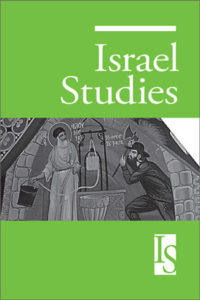מרכז מורשת יהדות בבל – סרטון תדמית
The Babylonian Jewry Heritage Center was established in 1973 to preserve the history of the Jewish community in Iraq and to ensure that it remains part of the future narrative of the Jewish nation. To this end, the Center fosters research, preservation and publication of the culture and folklore of Iraqi Jewry.
Adjacent to the Center is the Museum of Babylonian Jewry, opened to the public in 1988 and exhibiting chapters from the history of Babylonian Jewry throughout the generations over the course of more than 2,600 years.
The Jews Of Baghdad
Iraqi Jews had a significant role in the country’s contemporary history until the infamous “Farhood” ; AKA the Jewish Exodus from Iraq.
This brief video reminds us of some contributions to Iraq’s social and cultural spheres made by its Jewish community.
Avi Picard ~ Like A Phoenix: The Renaissance Of Sephardic/Mizrahi Identity In Israel In The 1970s and 1980s
 Abstract
Abstract
During Israel’s first decades, conflict between immigrants from Islamic countries and the Israeli establishment focused on questions regarding equality. The immigrants protested against discrimination in the labor market, against poor housing conditions, and against police brutality. The question of Mizrahi culture and identity was barely mentioned. In the 1970s and 1980s, however, the ethnic discourse in Israel shifted from economic issues to cultural issues. Different groups challenged the school curriculum, asking for more attention to the history and literature of Jews from Islamic countries. Mizrahi music started to develop on the fringe of the Israeli musical scene and moved slowly into the mainstream. Political parties (Tami and Shas) identified with Mizrahi identity and emphasizing it, started to appear and to achieve success. This article provides examples of the expression of identity and culture in different fields and analyzes the causes of this change.
The paper online (PDF-Format): https://www.researchgate.net/Like_a_Phoenix_
Ari Alexander ~ The Jews Of Baghdad And Zionism: 1920-1948
Introduction
The Jewish community in Baghdad virtually disappeared with the mass exodus of 120,000 Iraqi Jews to Israel between 1949-1951. This Jewish community lived in Iraq for approximately 2,500 years and my thesis looks closely at the years between 1920- 1948 in order to gain as much insight as possible into the complex set of economic, political and religious factors that coalesce to form the lived experience of Baghdadi Jews during this period. It is my contention that during this time, an historic and thus far irreversible break in Arab-Jewish relations occurred, and that Baghdad is a crucial arena to observe this shift as it unfolds. This thesis is a study of the impact of anti-Zionism, anti-Semitism and anti-imperial ‘Britishism’ on the Baghdadi Jewish community.
Aside from the obvious hatred sown by the conflict between Palestinians and Jews in Palestine, the relationship between Muslim, Christian and Jewish Arabs more generally was destructively altered by the Zionist project. This thesis aims to contribute to a body of literature that illuminates what went wrong in relations between Arabs and Jews in the modern Middle East. It is framed by the contemporary question of whether or not Zionism alone accounts for the deep-seated hostility towards Jews that is currently so widespread in the Arab-Muslim world. This question is of relevance to Zionist historiography, which is notably narrow in its interest in the subject. And it is also of interest to the uninformed public, which tends to hold an opinion—either that Arabs pathologically hate Jews or that Zionists are to blame for all of the troubles in the region.
—
The complete thesis: http://users.ox.ac.uk/~metheses/Alexander.pdf
Thesis submitted in partial fulfillment of the degree of Masters of Philosophy in Modern Middle Eastern Studies
Faculty of Oriental Studies – University of Oxford – 2004
Jordan Salama ~ From Exile To Exodus: The Story Of The Jews Of Iraq
Jewish Virtual Library ~ Jews Of Iraq
 One of the longest surviving Jewish communities still lives in Iraq. In 722 B.C.E., the northern tribes of Israel were defeated by Assyria and some Jews were taken to what is now known as Iraq. A larger community was established in 586 B.C.E., when the Babylonians conquered the southern tribes of Israel and enslaved the Jews. These Jews distinguished themselves from Sephardim, referring to themselves as Baylim (Babylonions). In later centuries, the region became more hospitable to Jews and it became the home to some of the world’s most prominent scholars who produced the Babylonian Talmud between 500 and 700 C.E.
One of the longest surviving Jewish communities still lives in Iraq. In 722 B.C.E., the northern tribes of Israel were defeated by Assyria and some Jews were taken to what is now known as Iraq. A larger community was established in 586 B.C.E., when the Babylonians conquered the southern tribes of Israel and enslaved the Jews. These Jews distinguished themselves from Sephardim, referring to themselves as Baylim (Babylonions). In later centuries, the region became more hospitable to Jews and it became the home to some of the world’s most prominent scholars who produced the Babylonian Talmud between 500 and 700 C.E.
During these centuries under Muslim rule, the Jewish Community had it’s ups and downs. By World War I, they accounted for one third of Baghdad’s population. In 1922, the British recieved a mandate over Iraq and began transforming it into a modern nation-state.
Iraq became an independent state in 1932. Throughout this period, the authorities drew heavily on the talents of the mall well-educated Jews for their ties outside the country and proficiency in foreign languages. Iraq’s first minister of finance, Yehezkel Sasson, was a Jew. These Jewish communities played a vital role in the development of judicial and postal systems.
In the 1936 Iraq Directory, the “Israelite community” is listed among the various other Iraqi communities, such as Arabs, Kirds, Turkmen, Muslims, Christians, Yazidis and Sabeans, and numbering at about 120,000. Hebrew is also listed as one of Iraq’s six languages.
Yet, following the end of the British mandate, the 2,700-year-old Iraqi Jewish community suffered horrible persecution, particularly as the Zionist drive for a state intensified. In June 1941, the Mufti-inspired, pro-Nazi coup of Rashid Ali sparked rioting and a pogrom in Baghdad during the Jewish Feast of Shavuot. Armed Iraqi mobs, with the complicity of the police and the army, murdered 180 Jews and wounded almost 1,000 in what became known as the Farhud pogrom. Immediately following, the British Army re-entered Baghdad, and success of the Jewish community resumed. Jews built a broad network of medical facilities, schools and cultural activity. Nearly all of the members of the Baghdad Symphony Orchestra were Jewish. Yet this flourisng environment abruptly ended in 1947, with the partition ofPalestine and the fight for Israel’s independence. Outbreaks of anti-Jewish rioting regularly occurred between 1947 and 1949. After the establishment of Israel in 1948 Zionism became a capital crime.
In 1950, Iraqi Jews were permitted to leave the country within a year provided they forfeited their citizenship. A year later, however, the property of Jews who emigrated was frozen and economic restrictions were placed on Jews who chose to remain in the country. From 1949 to 1951, 104,000 Jews were evacuated from Iraq in Operations Ezra & Nechemia (named after the Jewish leaders who took their people back to Jerusalem from exile in Babylonia beginning in 597 B.C.E.); another 20,000 were smuggled out through Iran.
Read more: https://www.jewishvirtuallibrary.org/jews-of-iraq




